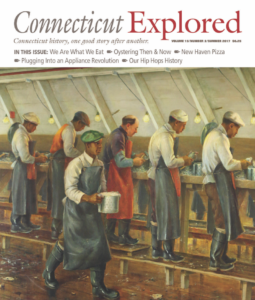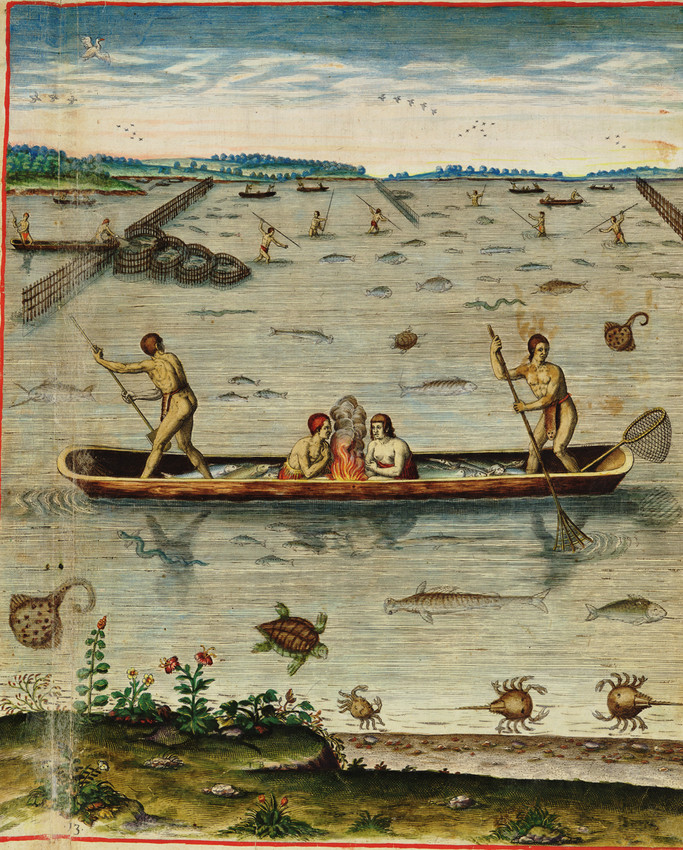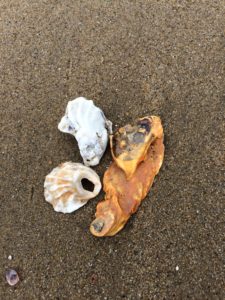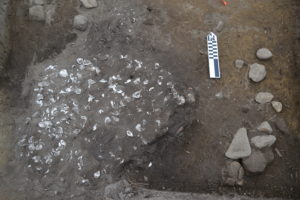(c) Connecticut Explored Inc. Summer 2017
SUBSCRIBE/Buy the Issue
Early Native Americans living in the region known today as Connecticut incorporated the Eastern oyster (Crassostrea virginica) into their diet several thousand years ago. Native oral tradition, archaeological evidence, and numerous ethno-historical accounts testify to the importance of oysters to Native communities for many thousands of years.
Oysters flourished in coastal marine areas, where ocean salt water mixes with fresh water coming from rivers and streams. Compared to other species of shellfish, the oyster can prosper in areas with lower salinity, and therefore the salt ponds that dotted the Connecticut shoreline were home to robust oyster populations, while dense oyster beds naturally formed near the mouths of those rivers where fresh water met the salt water of the sound.
In Connecticut, oysters are among the earliest shellfish encountered today by modern-day archaeologists studying ancient Indian shell heaps know as “middens.” These shell middens essentially contain all the empty shells from oysters consumed by Native peoples while at that location. According to Dr. Kevin McBride, director of research at the Mashantucket Pequot Museum, around three thousand years ago, changing environmental conditions facilitated extensive tidal flats that supported large populations of oyster and other shellfish. Evidence suggests that Native peoples quickly incorporated those shellfish into their diet. Early middens containing oysters found on the Connecticut shoreline date to between 3,500 and 2,500 years ago, while older middens were likely submerged as sea levels rose following the last glaciation period.
Oyster remains are commonly found near Native settlements, especially those along the Connecticut coast, from Greenwich to Stonington, including near the mouths of the Housatonic, Quinnipiac, Connecticut, Pequot (Thames), and Pawcatuck rivers. Today many smaller streams, rivulets, and paths along the shoreline have names such as the “Oyster River,” “Oyster Bay,” or “Oyster Road” as testimony to the importance of these oyster-producing areas.
When harvested regularly, this important coastal resource can serve as a food supply with one of the highest carrying capacities for human populations. This means that all members of the community, including small children and elderly people, could contribute to the food supply by gathering oysters. Oysters could be gathered by hand or raked up and stored in baskets. Their hardy shells make them transportable over long distances. Shell middens discovered around Mashantucket, for instance, contain oyster shells that were likely harvested 12 miles south along the shore or at Poquetanuck Cove several miles southeast. The empty shell of the oyster could also be fashioned into a suitable hoe or as a hand tool for scouring out a mishoon (dugout canoe).
The eastern oyster was harvested and consumed by Native peoples in a wide variety of ways. Sheri Pocknett, a Mashpee Wampanoag tribal member and chef at the Pequot Café at the Mashantucket Pequot Museum, describes the oyster as an incredibly important food that historically provided both protein and salts and minerals absorbed from the water. She detailed the numerous ways in which they were traditionally consumed, ranging from “oysters in the raw” to smoking or drying them for long-term storage. Oysters were also commonly added to succotashes and stews. The shellfish was also said to be an aphrodisiac.
Connecticut’s Native peoples maintained their oystering and shell-fishing traditions throughout the colonial period, into the years of the early republic and beyond. Many early deeds and treaties made by colonists with local Indians included provisions ensuring Native rights to access oyster beds in their traditional fishing grounds, though these rights were not always respected.
Alla Lynne Perkins Allyn (1892-1986) of Groton, recalled stories told by her relatives (and now held at the Mystic River Historical Society) about Pequot tribal members staying overnight in her grandfather’s barn in the 1830s on their way to and from the Mystic shoreline to shellfish in the spring. Also in the 1830s, Quinnipiac Indians actively worked their oyster beds on reserved lands east of New Haven harbor at the mouth of the Housatonic River.
Despite the challenges imposed by English colonization and centuries of dispossession by the Colony, and later State, of Connecticut, Native peoples maintained a continuity with the traditions of their ancestors that persists to this day. The historical importance of the eastern oyster as a valued food source to Native Americans and Europeans alike was officially recognized by the State of Connecticut in 1989 when the general assembly designated Crassostrea virginica as the state shellfish.
David J. Naumec is a museum consultant, historical researcher, and adjunct history professor.
Explore!
Read more about Native Americans in Connecticut on our TOPICS page.
Read more about oystering in Connecticut: “Connecticut Oystering,” Summer 2017




